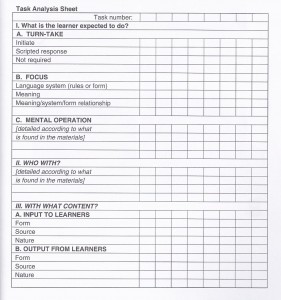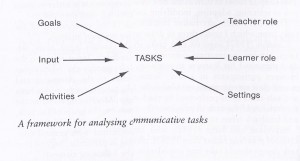Task-based Language Learning;
- Seeks to engage language learners pragmatically, [incorporating some kind of gap, information, opinion or reasoning]. This a “focus on the exchange of meaning” as opposed to form. However this does not neglect form over communication, Schmidt makes the point that he had been previously instructed on all of the new forms that he used during communicative output whilst he himself was learning Portuguese.
- Involves real-world processes of language use, Ellis [2003] refers to real-world meaning as achieving “situational authenticity“.
- Involve any of the four language skills.
- Engages cognitive processes. Ellis refers to cognitive processes such as classifying, evaluating, selecting, reasoning, sequencing information and transforming information.
- Has a clearly defined communicative outcome.
Tasks should be meaningful and interesting, allowing students to focus on their exiting knowledge, a focus on fluency. The Task Analysis sheet below can be used in both task design and analysis.
In relation to turn-taking, The Interaction Hypothesis, following the work Teresa Pica, has shown that interaction aids language acquisition in three different ways. Firstly learners “conversational modifications that arise through modification break down or segment the input into units until the learner can process more easily“. Secondly error correction given during communication means that learners are unlikely to make the same mistakes in future. Finally learners will be required to reformulate their utterances to create comprehensible input for their partner or group. Johnson [2003] suggests that, “you want the class members to interact as much as possible with as many different members of the class as possible” this comment was made in reference to genre and scenario and is an interesting starting point for an exploration of task content. The diagram below highlights the importance of both the learners’ and teachers’ role in task design and performance and encapsulates the vital elements of task based learning.
[Designing Communicative Tasks for the Communicative Classroom]
Task objectives/goals need clarity to avoid missed learning opportunities, a clear target can avoid frustration for both students and learners, specified objectives can also act as a student reference point. What do, might students find the most beneficial function? Decide on content, should content be easy, familiar or manageable, is the content advantageous or ambiguous is there content that the learners can manipulate? Students are likely to be primed into using a particular structure if that structure is used in the task’s content [Bock 1986] or a pre-task priming exercise, [Boston 2010]. If tasks are adaptable for different levels students will be able to work independently. Feedback must be considered, a key could be useful or monitoring as feedback, “when there is free production sample answers can be provided”, McGrath [2010].
| Task Type | Results | Associated Benefits |
| Tasks requiring learners to perform multiple activities; | Result in less fluent but more lexically complex output than single task conditions. | |
| Tasks with greater immediacy, here and now as opposed to there and then; | Result in more fluent less accurate production. For example students displayed more accurate production when describing pictures from memory than pictures in front of them. | |
| Tasks requiring reasoning and simple information transfer together. | These tasks are more cognitively demanding. | During these tasks students used a lot of logical connectors, e.g such as, if…then, therefore, because. |
Task evaluation requires adopting a critical approach to the tasks being used in one’s EFL classroom. Task evaluation procedures need to raise teachers’ awareness of any factors that may facilitate or impede task performance. The efficiency and effectiveness of tasks can be evaluated throughout stages of design and use to enable fine-tuning and to assess their suitability for different groups of learners.
Boston, J. S. (2010 ) Pre-task syntactic priming and focused task design ELT Journal 64 (2): pp.165-174.
Breen, M. (1989) The evaluation cycle for language learning tasks. In: Johnson, K.R. (ed). The Second
Language Curriculum. Cambridge: Cambridge University Press. pp.187-206.
Ellis, R. (2011) Macro- and micro-evaluation of task-based teaching. In Tomlinson, B. (ed). Developing Materials for Language Teaching. (2nd ed) London: Bloomsbury.
Ellis, R. (2003) Task-based Language Learning and Teaching – Oxford: OUP
Johnson, K. (2003) Designing Language Teaching Tasks. Basingstoke: Palgrove
Maley, A. (2011) Squaring the Circle – reconciling materials as constraint with materials as empowerment. In Tomlinson, B.. (ed) Materials Development in Language Teaching 2nd (ed). Cambridge: Cambridge University Press pp 379 -402
McGrath, I. (2002) Materials Evaluation and Design for Language Teaching. Edinburgh: Edinburgh University Press. (See chapter 6 Using the real – p103-138.)
Mishan, F. (2010) Task and task authenticity: paradigms for language learning Materials Development. Oxford Peter Lang. pp.149-171
Nunan, D. (1989) Designing Tasks for the Communicative Classroom. Cambridge: Cambridge University Press.
Roberts J.T. Demystifying Materials Evaluation System 24(3) pp.3750-389. Department of Language and Linguistics University of Essex
Vasiljevic, Z. (2011) The predictive evaluation of language learning tasks. English Language Teaching 4 (1): pp.3-10


